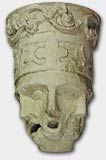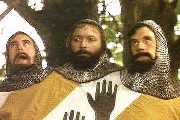They tend to carve things like this

or this

Get it? One self/personal substance/entity (represented by the one head) with three faces, i.e. ways of presenting himself or interacting with us. Or alternately, three ways of living (with or without us in the picture).
To be fair, though, one might think that the artists’ inspiration was something like the constitution theory of presented by Mike Rea and Jeff Brower in this paper. (Or much more accessibly, in pp. 8-10 of this one. Stay tuned – these will eventually be discussed here.) Roughly, this is the view that the three persons, though none are identical to one another, are “numerically the same”, as they are composed of something analogous to one batch of divine stuff/matter. Yeah, it’s going to be a bumpy ride when I take a shot at ‘splaining this one… 🙂
Again, maybe this could be a way to represent the view of Biola’s dynamic duo, Craig and Moreland… Then again, maybe this would be better. 🙂

Technorati Tags: modalism, art, trinity, constitution trinitiarianism, moreland, craig, brower, rea, theology

Belated comment — you can now see both divine and demonic three-faces-on-one-head depictions at http://commons.wikimedia.org/wiki/Category:Three_faces_on_one_head
They were “mainstream” in the sense of being within the acceptable range of artistic representations in Western Europe for a few centuries (though by no means artistically dominant during that period), but the Catholic church has repudiated this form of representation at least since the Counter-Reformation (I’m pretty sure that I read in a history of Christian symbolism — maybe the 19th-century Didron book — that the making of new images of this type was forbidden by the Church authorities), while Protestants pretty much never liked them.
So considered within the sweep of overall world Christian history, they’re more or less a minor local temporary aberration of iconography…
P.S. I agree that the main objection to them would have been theological incorrectness, not idolatry.
Jeff – you’re missing the point, my friend. I don’t think that the Catholic carvers of those pieces thought that the Father and Spirit each had bodies. Rather, they understood the mainstream, orthodox, creedal version of trinitarianism as meaning what I call FSH modalism – the three faces in one head aren’t to be taken literally, but as representing the three “persons” / personalities God has, is, or contains. So there’s no use in trying to portray them as obviously non-Christians. I can’t believe you’ve incited me to actually (sort of) defend the artists! 😉
Thanks for the interesting link – I will read it.
Dale, I would recommend the following Should we make Images of Jesus?.
You state A good number of people understand the formula “three hypostases in one ousia†something like that way.
I seriously doubt this Dale. Although you do qualify your statement with people not Christians. Whether anyone understand “three hypostases in one ousia” that way, has no bearing on the truth and in fact is false since the Father nor the Spirit has a body.
I understand images are used for teaching aids, but these teaching aids represent a false God.
I don’t think the images violate the 2nd commandment, which has to do with making images for idolatrous purposes, which was a big problem back in OT times.
You guys can assert that the images are totally off base, but they do represent how many Christians think about God – one being, three ways of interacting or modes of presentation. A good number of people understand the formula “three hypostases in one ousia” something like that way.
Also, I don’t know the exact origin of those images (other than the Monty Python one), but I’ll wager that they’re from Catholic churches. So they represent a mainstream problem, whatever the JWs may use them for.
Right, the images are totally off base and cults, like the JWs use them to their advantage. One of the major problems with these pics is that the Father does not have a body of flesh and bone, neither does the Holy Spirit. Second, these images violate the 2nd Commandment.
Those representations were modestly popular in the late middle ages and early renaissance, but I don’t think that they’re considered proper iconography or symbolism by the modern Catholic church, and Protestants never really liked them in the first place… See http://en.wikipedia.org/wiki/Image:Trinity_faces.jpg
Hi Mike,
Yeah, I could do a whole series on bad analogies. It would get old though! 🙂
What I really should do, is say exactly why I think it isn’t enough to content ourselves with multiple, seemingly inconsistent analogies. I’ll probably do that when we go into the subject of “mysteries”.
Hey Randal,
I’m going to hold off on this, as I want to do a full discussion of Moreland & Craig vs. Dan. But on the face of it, it looks like a tough problem if it turns out that God isn’t a god! It is surely right that non-personal entities or pseudo-entities (e.g. soccer teams) can be described as doing things. But only persons act in the primary sense of acting.
This is a bit off topic perhaps, but you mentioned Craig and Moreland with their “whole/part” view of the Trinity. As you know, Daniel Howard-Snyder argues that one of the untoward consequences thereof is the implication that God is not a person (only Father, Son, and Spirit are persons and they are but parts of the one God). One of Snyder’s arguments is that God is described throughout scripture as an agent (and thus personal) (for instance, God creates (Gen. 1:1-2), and thus Craig and Moreland’s view must be false, for one cannot attribute personal/agential characteristics to a non-agent. However, couldn’t one respond that all references to personal agency within scripture are in fact references to one (or more) of the persons? Indeed, I suspect most (Christian) theologians today would argue that Gen. 1:1-2 describes the Father creating through the persons of the Son and Spirit.
Dale,
I wondered when the discussion would get here, and this is a fine time to introduce the triple point of water, no? 🙂
I’m looking forward to the discussion of Rea and Brower.
Mike
Comments are closed.